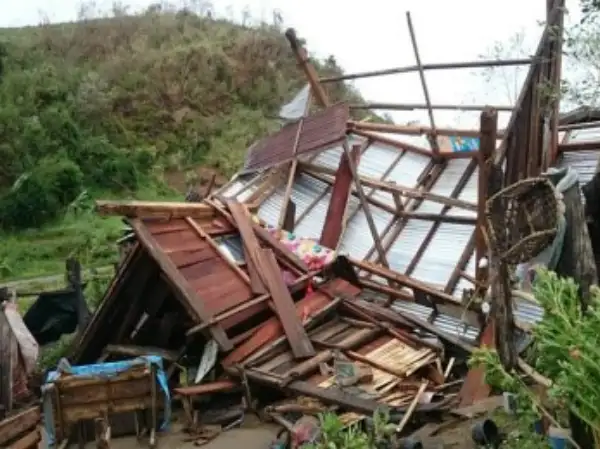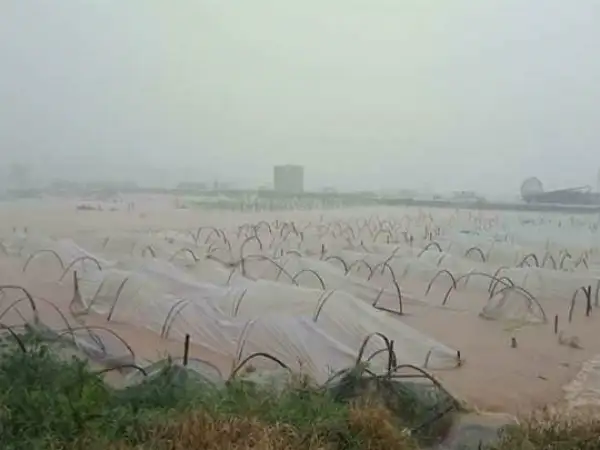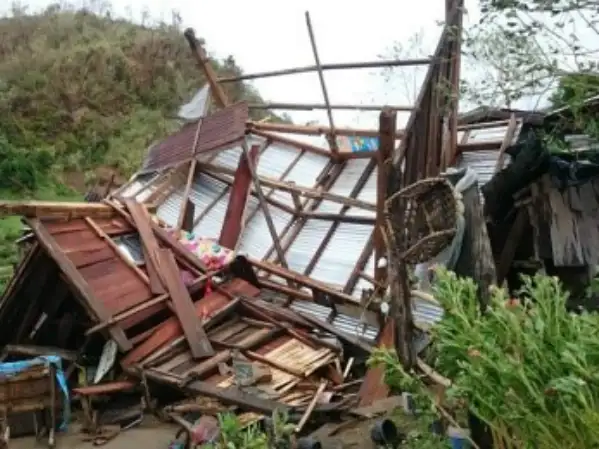

Houses damaged during Typhoon Mangkhut.
The Church and local Caritas network have sprung into action in the Philippines, where 80 per cent of people are Catholic.
Caritas Philippines has mobilised hundreds of volunteers through its church networks, to work in affected dioceses and get aid to evacuation centres. They are also out in the field doing rapid assessment reports of damage and supporting families who were affected but couldn’t reach evacuation shelters.
Crucially, their expertise is respected by local government agencies, who they are working alongside.
Jonathan Jose Calderon, the Mayor of Roxas, Isabela, said:
"Both the government and the church were prepared. We have been coordinating very closely with each other to assess the damages and assist the most vulnerable".
How can I help?
CAFOD and the Caritas network are providing emergency relief to affected communities. Thanks to funds from Emergency Response Team donors, we get funding out to our local organisations, who know best where aid is needed most, making a big difference to vulnerable people.
Please keep the people of the Philippines in your thoughts and prayers.
Pray for the people of the Philippines
And thank you for the support you are able to give. Join our emergency response team
What has happened?
On Saturday 15 September, ‘super-typhoon’ Mangkhut made landfall in the Philippines and has left at least 65 people dead and more than 40 trapped in a landslide.
The Philippines is hit by about 20 typhoons and storms a year, but Mangkhut, known locally as Typhoon Ompong, was the strongest so far in 2018 - with winds reaching 180mph.
Some areas of the country are still left without power and many bridges have been destroyed. Most petrol stations, grocery stores and local markets remain closed.
Our local aid agency, Caritas Philippines, known as NASSA, are already on the ground coordinating the humanitarian response and delivering aid to people who have reached the safety of evacuation shelters.
How have people been affected?
According to the Philippines government, nearly 600,000 people have been affected by Typhoon Mangkhut and almost 250,000 people have sought refuge in evacuation centres or with host families. In the Northern Luzon region, that bore the brunt of the typhoon, houses have been destroyed and many acres of crops and farmland have been devastated.
The UN estimates that the Typhoon has wiped out $265 million of crops, one month before harvest is due. This is going to have a massive impact on the food supply across the whole of the Philippines.


Flooded rice fields after Typhoon Mangkhut.
One of our local aid workers in Luzon spoke to Emerita, 31, a farmer from Caoayan, Ilocos Sur. When Typhoon Mangkhut came through her hometown, her rice fields were severely damaged. Before the typhoon, she was expecting to harvest at least six sacks of rice. Now, she's not even sure if they will harvest one sack.
"The saddest part is that the land is not ours,” said Emerita. “Every time we harvest, we need to give one sack to our landowner as payment for the use of the land. What are we going to give them now?"


Yolanda, 40, whose house was destroyed by Typhoon Mangkhut.
Yolanda, 40, lives with her husband and four children in Bantaway, San Vicente, Ilocos Sur. They have been staying in a makeshift house for the last four years, but this was destroyed by the Typhoon.
"We are one of the informal settlers in our barangay (village) and Typhoon Mangkhut toppled our house down,” said Yolanda.
“We have just finished rebuilding it from scraps because we don't really have anything to build with."
What are the needs of people who have been affected?
In Isabela, the second largest province in the Philippines, 90 per cent of the crops were damaged and 600 families were temporarily housed in the NASSA evacuation centres where they received water, food and shelter.
Local aid workers report, that there is a lot of work to be done to support people to re-start their farming and earn a living.
Join our emergency response team
Fr. Peter Rambac, Parish Priest in Roxas, Isabela, said:
“There are already more than 100 people in the evacuation area, just from our parish.
“There are a lot of things that we really need right now, particularly food, rice, some tinned goods, noodles, clothes, towels, blankets, and water. So, now we are knocking at your door and asking for your generosity for whatever help you can extend here in our diocese.”
What has been the impact of the emergency response to date?
NASSA, who have a wealth of experience responding to emergencies and mobilising thousands of volunteers through Church networks, established local social action centres and working alongside Caritas Manila and the Catholic Relief Services (CRS), have deployed emergency staff and volunteers and prepared emergency aid kits.
Father Edwin A. Gariguez, Executive Secretary for NASSA / Caritas Philippines, said:
"Our local aid workers and resources have already been deployed in several areas delivering and distributing relief-aid where it’s needed most.
“We are also monitoring government actions to complement our responses if necessary.”
How is CAFOD responding?
In support of our local aid agency NASSA and its church networks, reaching some of the most vulnerable communities affected by the Typhoon, CAFOD has initially pledged £30,000 to help them to scale up their vital emergency response and reach more people.
Help us to make sure we can always respond immediately by joining our response team
What is the church doing?


Following Typhoon Mangkhut, the local Caritas team packs the initial relief goods for distribution to families in the evacuation centres in Ilagan, Isabela.

